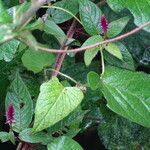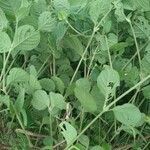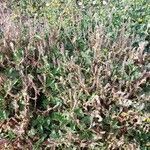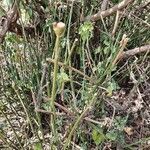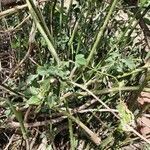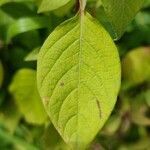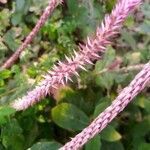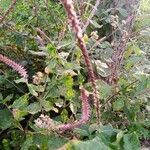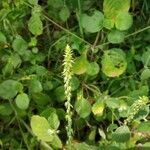Erect rather stiff herb ¼-1¼ m high, usually branched from near the base; branches obliquely erect or ascending; stem angular-ribbed, thickened above the nodes, hard, more or less densely hairy. Leaves oval-obovate or elliptic-oblong, from an acute or obtuse base, acuminate or not, acute, obtuse or rounded, entire, flat or more or less wavy, more or less densely hairy or, barring the nerves, glabrous or subglabrous, 1¼-10 cm by ¾-5¼ cm; petiole ½-1½ cm. Spikes terminal, erect, 10-75 ½-15 cm peduncle included); rachis rather robust, stiff, angular-ribbed, more or less densely clothed with appressed or more or less patent, rather long white hairs; bracts long-acuminate, not pungent, 2-3½ mm long, before anthesis erect, afterwards spreading, at last quite reflexed as often is the fruiting perianth also, ± silvery; bracteoles appressed against base of perianth. Spines 2¾-4½ mm, shining, often tinged with purple, sharp; basal wings almost throughout their length adnate to spine but most easily separating from it, 1½-2 mm long. Tepals ovate-lanceolate, very acute, green with pale margins, with 3 or more rather strong nerves, during anthesis 3½-5½ mm long, afterwards up to 4½-6½ mm, hardening and becoming pungent. Filaments (staminal cup included) 2¼-3½ mm; pseudo-staminodes truncate or crenulate, just below the apex with a dorsal long-fringed scale far exceeding the top of the pseudo-staminode itself; ovary turbinate; style 1-2 mm. Utricle rounded at the base, 2½-2¾ mm long.
Herb 0.3–1.5 (–2) m high. Leaves: petiole 2–20 (–27) mm long; lamina ovate to elliptic to lanceolate, (10–) 22–144 (–155) mm long, (5–) 10–67 (–77) mm wide, base cuneate to attenuate, margin entire, apex acute to obtuse, rarely acuminate; dark to olive green above, light green to cream below, hairs dense to covering veins on underside only. Inflorescence a spike, usually terminal, (5–) 10–25 (–40) cm long; peduncle (1–) 4–10 cm long; bract ovate to broadly ovate, 2–3.5 mm long, glabrous. Bracteole wings elliptic to ovate or broader, fused to vein, 1–2.2 mm long; vein extrudes as spinescent tip 1.3–3.1 mm long; margins with a few short hairs. Tepals 5, narrowly ovate to lanceolate, green to yellowish; apex acute, not spinescent, 3.5–7.1 mm long, 1.1–1.9 mm wide; margins with a few short hairs. Stamens: filaments 1.1–2.7 mm long; anthers 0.45–0.8 mm long; pseudostaminodes rectangular, 0.7–1.3 mm long, 0.4–0.9 mm high, with apex covered by a fimbriate appendage 0.5–1 mm long. Style 0.7–2.2 mm long. Fruit an indehiscent utricle, cylindrical, 2–3 mm long, 1–1.8 mm wide. Seed ellipsoid to cylindrical, 1.8–2.6 mm long, 1–1.7 mm wide, light to reddish brown, smooth with round cells.
Herb to 1 m, whitish-pubescent, becoming somewhat woody at base; stems obscurely angled, purplish. Leaf-blade lanceolate, ovate, oblong, elliptical, oblanceolate, suborbicular or orbicular, 0.5-19 x 6 cm, often with undulate margin, apex acuminate or rounded, sometimes apiculate, dark green and pubescent above, lighter green and often more densely pubescent below. Spikes to 60 cm long, slender, with lanate axes, sometimes recurved or flexuous at apex; bracts white, hyaline, narrowly lanceolate, ca. 3 mm long; bracteoles purple-tinged, lanceolate, 3-4 mm long, base membranous and suborbicular, central vein protracted into a tawny, subulate, conspicuously indurated to 1.5 mm long awn. Tepals pinkish, brown, purplish or white, lance-elliptical, 3.7-4.5 mm long, apiculate, with hyaline margin; ovary turbinate, thickened and papillate above, stigma unlobed, scarcely enlarged. Utricle truncate at apex, ca. 2 mm long.
Erect or procumbent pubescent annuals or perennials, the usually branched stems to 2 m. long. Leaves scantily to densely pubescent, ovate to orbicular, apically acuminate to rounded, basally cuneate to rounded, 2-25 cm. long, 2-9 cm. broad; petioles 2-25 mm. long. Inflorescences of terminal and axillary pedunculate spikes, 3-40 cm. long, 6-12 mm. broad, the flowers deflexed. Flowers perfect; bracts and bracteoles subequal, 2-3.5 mm. long, ovate, spinescent, the tips rarely arcuate but not uncinate; sepals 4-5. greenish white, subequal, hypogy-nous, obscurely nerved, 4-7 mm. long; stamens 5, united below into a short tube; pseudostaminodia lacerate, exceeded by the 4-locellate anthers; ovary obovoid; style 1, filiform, at anthesis longer than the ovary; stigma 1, capitate. Fruit an indehiscent turbinate utricle; seeds cochleate-orbiculate, reddish brown, about 1 mm. broad.
Herbs perennial, 20-120 cm tall. Stem quadrangular, pubescent; nodes slightly inflated; branches opposite. Petiole 0.5-1.5 cm, somewhat hairy; leaf blade broadly obovate or elliptic-oblong, 1.5-7 × 0.4-4 mm, papery, both surfaces hairy, base cuneate or rounded, margin entire or undulate, apex obtuse, with a mucro. Spikes terminal, erect, reflexed after anthesis, 10-30 cm; rachis angular, stout, densely hairy. Bracts lanceolate, 3-4 mm, apex acuminate; bracteoles spiny, shiny, 2.5-4.5 mm, rigid, base 2-winged; wings 1.5-2 mm, membranous, margin entire. Tepals lanceolate, 3.5-5 mm, with a vein. Stamens 2.5-3.5 mm; pseudostaminodes truncate or crenate at apex, fimbriate and ciliate. Utricles ovoid, 2.5-3 mm. Seeds brown, ovoid, ca. 2 mm. Fl. Jun-Aug, fr. Oct. 2n = 42, 48, 84, 96.
Herb to c. 1 m high. Stems lax, woody at base and ribbed, densely hairy with hairs somewhat appressed. Petioles 5-20 mm long, silky, often pink. Lamina 3-9 × 2-6 cm, broadly ovate, slightly rhomboid, clothed in appressed hairs above and below, silky canescent on young parts, crenulate or crenate, attenuate at base, acute or shortly acuminate. Infl. to 15 cm long; peduncle white-villous. Fls becoming retrorse, often tinged red. Bract c. 3 mm long, ovate, long-acuminate; bracteoles slightly > bract, with broadly scarious base and a long, subulate spine above. Tepals 3-5 mm long, shining, acute, becoming pungent in fr. Fr. 2-2.5 mm long.
Stamens 5, the filaments 1.5–4.5(6) mm. long, alternating with subquadrate pseudostaminodes. Typically the apex of the latter curves slightly inwards as a narrow, crenate or entire, often very delicate flap, while from the dorsal surface arises a fimbriate-ciliate scale extending across the width of the pseudostaminode; not rarely, however, this is reduced to a “stag's horn”process at the centre of the dorsal surface or a shallow, dentate rim, or even becomes small and filiform, or else subapical or apical so that the pseudostaminode appears simple (this usually in small forms of var. sicula).
A coarse rambling annual herb. It has many branches but the branches are not close together. The plant grows 0.5 to 2 m high and spreads 0.5 m across. The stem is erect, hairy and woody. It often has many joints. The leaves are in opposite pairs. The leaves are 6 to 15 cm long, somewhat wedge shaped and slightly hairy and tapering to a point. The flower spikes are 10 to 50 cm long with small green flowers about 5 mm long. The chaffy flowers on long spikes tend to eventually point downwards. They have rigid curved spines near the flower. The seeds attach to clothes.
Plants perennial or annual. Stems 0.4-2 m, pilose or puberulent. Leaf blades elliptic, ovate, or broadly ovate to orbiculate, obovate-orbiculate, or broadly rhombate, 1-20 × 2-6 cm, adpressed-pubescent abaxially and adaxially. Inflorescences to 30 cm; bracts mem-branous; bracteoles long-aristate, spinose; wings attached at sides and base. Flowers: tepals 4 or 5, length 3-7 mm; pseudostaminodes with margins fimbriate at apex, often with dorsal scale. Utricles ± cylindric, 2-4 mm, apex truncate or depressed.
Erect, perennial herb, 0.2-2.0 high, sometimes bushy or scandent, sometimes flowering in first year. Leaves opposite, entire, petiolate. Inflorescence a ± slender, simple or branched, elongated, solitary or fasciculate spike up to 0.3 m long, terminal on stem and branches; flowers at first congested and ± patent, finally usually laxer and deflexed. Flowers bisexual, solitary in axils of bracts; tepals 4 or 5, 1-3(-5)-nerved, narrowly lanceolate. Flowering time July-May. Seed cylindrical.
Leaves elliptic, oblong or ovate, acute or acuminate to almost circular and very obtuse, gradually or abruptly narrowed below, (2)5–22 (28) × 1.3–8 (10) cm., indumentum varying from subglabrous on both surfaces through subglabrous above and densely appressed-canescent below to more or less densely tomentose on both surfaces; petioles of main stem leaves 3–25( 30) mm., shortening above and below.
Perennial herb (sometimes woody and somewhat suffrutescent), occasionally flowering in the first year, 0.2–2 m., stiffly erect to subscandent or straggling and more or less prostrate, simple to much-branched, stems stout to very weak, distinctly to obscurely 4-angled, striate or sulcate, subglabrous to densely tomentose, the nodes more or less shrunken when dry.
Perianth whitish or pale green to red or purple, segments 5, 3–7 (10) mm. long, the outer pair longest, narrowly lanceolate to lanceolate, very acute, with a distinct midrib and 2 obscure to distinct lateral nerves, narrowly or moderately pale-margined.
Bracteoles 1.5–4.5(6) mm., the basal wings one third to one quarter the length of the spine and more or less adnate to it (sometimes free above or tearing free), typically tapering off above but not rarely rounded or truncate.
Shortly hairy, sprawling perennial to 50 cm. Leaves elliptic, often attenuate, pale beneath. Flowers in congested terminal and axillary spikes, nodding, white.
A common weed of waste places, very variable, much-branched, 1–6 ft. high, sometimes subscandent, sometimes woody
Bracts lanceolate or narrowly deltoid-lanceolate, pale or brownish-membranous, 1.75–5(6) mm. long, glabrous.
Inflorescences at first dense, finally elongating to (5)8–34 (40) cm.; peduncles (0.6–1)1–6 (7.5) cm. long.
Seed filling the capsule, oblong-ovoid, smooth.
Capsule oblong-ovoid, 1–3(5) mm. long.
Style slender, 1–4(6) mm. long.
Flowers green or pinkish.
